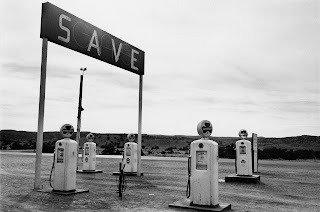 |
| Robert Frank, "Santa Fe" (1955) |
A special shout-out to Gideon Lewis-Krauss for his terrific
“What We See When We Look at Travel Photography,” in this week’s New York Times Magazine, a delicious
essay connecting Claude Lévi-Strauss’s Tristes
Tropiques, Walker Percy’s “The Loss of the Creature,” Paul Fussell’s Abroad, Bruce Chatwin’s Songlines, Edward Hopper’s Gas, Geoff Dyer’s The Ongoing Moment, Janet Malcolm’s Diana and Nikon (a collection of her New Yorker photography pieces), Elizabeth Bishop’s “Filling Station” (The New Yorker, December 3,
1955) with transfixing “road” photographs by Henri Cartier-Bresson, Lee
Friedlander, Robert Frank, and Gary Winogrand. The core of the piece’s
combinational delight is Lewis-Krauss’s multilayered interpretation of his
friend David’s Instagram image of a nighttime gas station. “ ‘What is it,’ his
caption asked, ‘about #gasstationsatdusk?’ ” Lewis-Krauss’s answer is
brilliant:
It wasn’t an act of representation at all, and it certainly
wasn’t private. It was the expression of affect he wanted to communicate in
that moment — something a little smart, and a little sad, and a little funny,
and all in all very David. The image, an internet square of labyrinthine self-referentiality
— a photograph that recalled a painting that was at home in a poem — recalled
for me a different line of Geoff Dyer’s, where he quotes John Berger on Paul
Strand’s portraits: They arrested a moment “whose duration is measured not by
seconds, but by its relation to a lifetime.”
The “lifetime” Berger is referring to is, I think, the
lifetime of Strand's subjects. Berger, in his superb essay, writes, “Strand’s
photographs suggest his sitters trust him to see their life story.” Lewis-Krauss, in his piece, seems to be
saying that David’s gas station photo is self-referential - “the expression
of affect he wanted to communicate in that moment.” I agree with both writers.
Photographs have a double aspect, as much that of a mirror as of a lens.




.jpg)







No comments:
Post a Comment